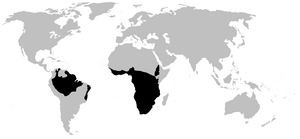Pipidae facts for kids
Quick facts for kids Pipidae |
|
|---|---|
 |
|
| An African Dwarf Frog pair during amplexus (mating embrace). | |
| Scientific classification | |
| Kingdom: | |
| Phylum: | |
| Class: | |
| Subclass: | |
| Superorder: |
Batrachia
|
| Order: | |
| Suborder: | |
| Family: |
Pipidae
|
 |
|
| Where Pipidae frogs live (shown in black). | |
The Pipidae is a group of frogs that are quite unique. What makes them special? They don't have tongues! Instead, they use their hands to grab food and push it into their mouths. There are more than 30 different species (types) of Pipidae frogs. You can find them living in warm, tropical parts of South America and Africa.
These frogs are almost always found in water. They have flat bodies and webbed feet, which help them swim really well. They are also known for their interesting ways of eating and reproducing.
Contents
What Makes Pipidae Frogs Special?
Pipidae frogs are different from most other frogs in a few key ways.
No Tongues!
Most frogs use their long, sticky tongues to catch insects and other prey. But Pipidae frogs don't have tongues at all! Instead, they use their strong front legs and hands to scoop up food. They can also use a special suction method to pull food into their mouths. This unique way of eating helps them catch food underwater.
Living in Water
These frogs are mostly aquatic, meaning they spend almost all their lives in water. They have bodies that are perfectly designed for swimming. Their skin is smooth and slimy, and they have powerful, fully webbed back feet that act like flippers. This helps them move quickly through ponds, rivers, and swamps.
How They Hear
Pipidae frogs also have a special way of hearing. Unlike many other frogs, they don't have external eardrums (the visible part of the ear). Instead, they use a unique system where their lungs help them hear sounds underwater. This allows them to detect vibrations and sounds from other frogs or predators in their watery homes.
Where Do Pipidae Frogs Live?
Pipidae frogs are found in two main parts of the world:
- Africa: Many species, like the African Dwarf Frog and the African Clawed Frog, live in various parts of sub-Saharan Africa. They can be found in slow-moving rivers, lakes, and temporary ponds.
- South America: The famous Surinam Toad, for example, lives in the tropical rainforests of South America. They prefer calm, shallow waters.
These frogs thrive in warm, humid environments. They often hide among plants or at the bottom of the water, waiting for food to come by.
Different Kinds of Pipidae Frogs
The family Pipidae includes several interesting groups of frogs:
- Hymenochirus - These are the Dwarf Clawed Frogs. They are small and popular as pets because they are fully aquatic and peaceful.
- Pseudhymenochirus - This group includes Merlin's Clawed Frog, which is also a small, aquatic frog found in parts of West Africa.
- Xenopus - These are the Common Clawed Frogs, like the African Clawed Frog. They are larger than dwarf frogs and are often used in scientific research.
- Silurana - This group includes Tropical Clawed Frogs. They are similar to Xenopus but have some different features.
- Pipa - These are the Surinam Toads. They are very flat and have a unique way of raising their young, where the eggs develop in pockets on the mother's back!
Reproduction and Life Cycle
Pipidae frogs have fascinating ways of reproducing. Many species, like the African Clawed Frog, lay their eggs in the water. The eggs hatch into tadpoles, which then grow and change into adult frogs.
The Surinam Toad (from the Pipa group) has one of the most unusual reproduction methods in the animal kingdom. After the female lays her eggs, the male helps to press them into the skin on her back. The eggs then get covered by a layer of skin and develop there, safe from predators. When the tiny froglets are ready, they burst out of the mother's back!
See also
 In Spanish: Ranas sin lengua para niños
In Spanish: Ranas sin lengua para niños

